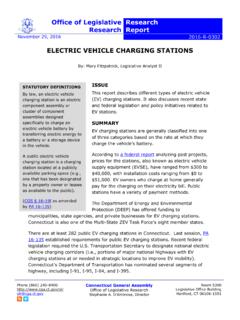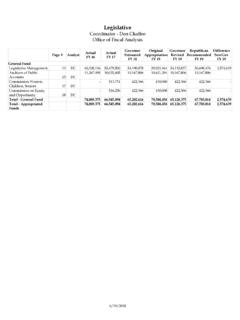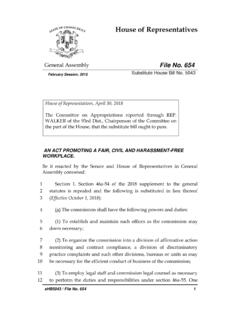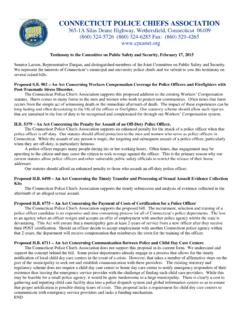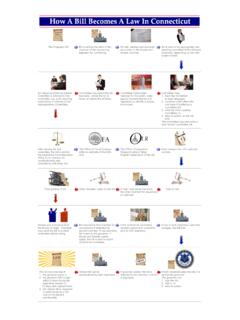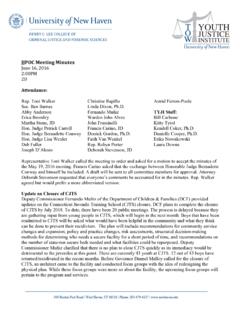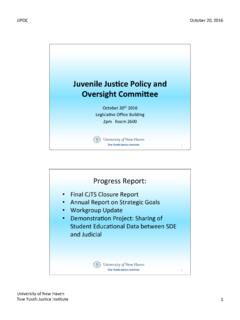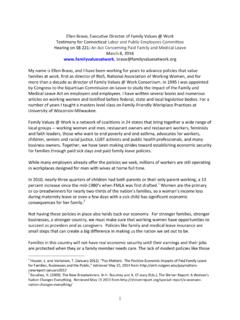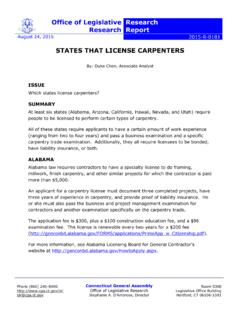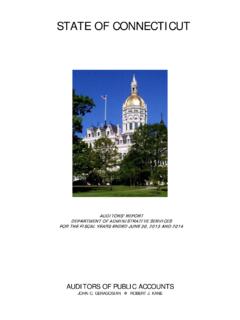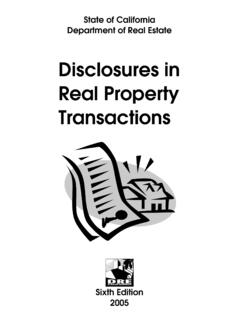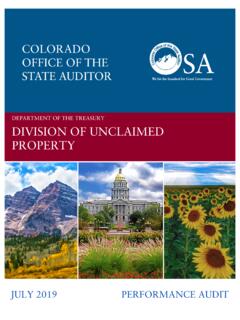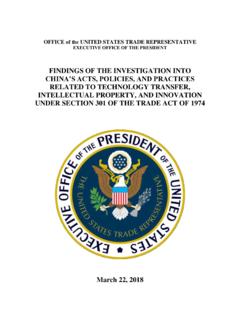Transcription of Real Estate Conveyance Tax - Connecticut General Assembly
1 Connecticut General Assembly Office of Legislative Research Stephanie A. D Ambrose, Director (860) 240-8400 Room 5300 Legislative Office Building Real Estate Conveyance Tax By: Rute Pinho, Chief Analyst July 9, 2020 | 2020-R-0020 Issue Explain Connecticut s real Estate Conveyance tax. This report updates OLR Report 2017-R-0107. Summary State law generally requires a person who sells real property for at least $2,000 to pay a tax on the property s Conveyance . The tax has a state and municipal component and ranges from 1% to of the sales price, depending on the property type and the municipality in which the property is located.
2 The seller must pay the tax before the deed can be recorded. Connecticut also imposes a controlling interest transfer tax on real Estate transferred through the sale or transfer of a business entity that owns an interest in Connecticut real property valued at least $2,000 or more. The tax is designed to apply to real Estate transfers that are not subject to the Conveyance tax because there is no change in the property s deed. Connecticut s Real Estate Conveyance Tax The real Estate Conveyance tax has two parts: a state tax and a municipal tax.
3 The applicable state and municipal rates are added together to get the total tax rate for a particular property Conveyance . The combined rate is applied to the property s sales price. The seller pays the tax when he or she conveys the property . Municipal town clerks collect the tax and remit the state share to the state Department of Revenue Services (DRS) (CGS 12-494 et seq., as amended by PA 19-117, 337). 2017-R-0107 July 9, 2020 Page 2 of 4 State Tax Table 1 lists the state tax rates by property type. The rate is of (1) the first $800,000 of the sales price of a residential dwelling ( , single family home or condominiums); (2) the full sales price of residential property other than residential dwellings ( , apartment buildings) and unimproved land (including farm, forest, and open space land); and (3) the amount of unpaid mortgage and interest on a property conveyed to a financial institution by a delinquent mortgagor.
4 A rate applies to (1) sales of nonresidential property other than unimproved land and (2) any portion of the sales price of a residential dwelling that exceeds $800,000 and is less than or equal to $ million. Beginning July 1, 2020, a rate applies to any portion of a residential dwelling s sales price that exceeds $ million. However, certain taxpayers may qualify for a state income tax credit for the amount paid at the rate, as described further below. Municipal Tax The municipal tax can range from to , depending on the municipality in which the property is located.
5 The base rate is for all municipalities, plus an additional tax of up to if the property is located in an eligible municipality that has chosen to impose the increased rate. Table 2 lists the 19 municipalities eligible to adopt the increased rate, which comprise the 18 "targeted investment communities" and a municipality with a manufacturing plant that qualifies for enterprise zone benefits ( , Bloomfield). With the exception of Groton, Stamford, and Thomaston, all of the eligible municipalities impose the maximum additional Conveyance tax.
6 Stamford imposes an additional tax of (1) on properties sold for up to $1 million and (2) on all other properties. Groton and Thomaston do not impose the additional tax. Table 1: State Conveyance Tax Rates by property Type property Type State Rate Unimproved land Residential dwelling (portion of sales price $800,000) Other residential property property conveyed by a delinquent mortgagor Nonresidential property (excluding unimproved land) Residential dwelling (portion of sales price > $800,000 and $ million) Residential dwelling (portion of sales price > $ million) Table 2.
7 Local Option Conveyance Tax Eligible Municipalities Bloomfield Bridgeport Bristol East Hartford Groton Hamden Hartford Meriden Middletown New Britain New Haven New London Norwalk Norwich Southington Stamford Thomaston Waterbury Windham 2017-R-0107 July 9, 2020 Page 3 of 4 Exemptions The law exempts various types of transactions from the state and local tax, including the following: 1. transfers between spouses; 2. conveyances pursuant to certain court decrees, including as a result of (a) an annulment, dissolved marriage, or legal separation or (b) foreclosure by sale; 3.
8 Transfers of property to any nonprofit organization organized to hold undeveloped land in trust for conservation or recreation purposes; 4. deeds made pursuant to corporate mergers; 5. transfers of a principal residence where the gross purchase price is less than the total amount the seller owes on the property for mortgages and tax liens ( , short sales ); and 6. transfers of certain principal residences with concrete foundations that have deteriorated due to the presence of pyrrhotite (CGS 12-498, as amended by PA 19-117, 336). A full list of Conveyance tax exemptions is available in DRS s Conveyance tax return instructions.
9 Revenue The state collected approximately $ million in state Conveyance tax revenue in FY 19, up from $ million in FY 18 and $ million in FY 17 (DRS FY 19 Annual Report, pg. 70). Municipalities collected $ million in FY 18 (according to the Office of Fiscal Analysis). property Tax Credit Against the Income Tax Beginning with the 2021 tax year, taxpayers who paid Conveyance tax at the rate may claim a property tax credit against their state income tax liability based on the amount they paid in Conveyance tax at this rate. Taxpayers who claim the property tax credit on this basis are not subject to the credit s income eligibility limits or $200 maximum.
10 By law, eligibility for the property tax credit is limited to state residents. Taxpayers may use the Conveyance tax payment as the basis for the property tax credit for three years, beginning in the third tax year after the year in which the taxpayer paid the Conveyance tax. The credit in each year cannot exceed of the amount of Conveyance tax the taxpayer paid at the rate. If a taxpayer does not use the full credit in a given year because it exceeds what the taxpayer owes in income tax or paid in property tax, then the taxpayer may carry the unused portion forward for up to six successive tax years.
